Along with brushing and flossing, using mouthwash should be part of your oral health routine to prevent gingivitis, gum disease, and to keep your breath smelling fresh, just to name a couple benefits. Along with these, here are four benefits of using mouthwash and why it should hold a space in your bathroom cabinet.
- Preventing Plaque Build-Up: The keyword here is build-up. Regular use can stop plaque from forming and hardening on your teeth, but it is not a miracle worker and cannot remove the plaque that is already there and solidified. Therefore, regular brushing, flossing, and a trip to the dentist is needed to remove the existing plaque. Mouthwash is still a great preventative tool to use afterwards to prevent the issue from happening again.
- Makes Brushing and Flossing More Effective: People commonly use mouthwash after brushing and flossing their teeth, but did you know that it can be beneficial to use it before brushing and flossing? This is because mouthwash has the ability to remove particles that are trapped in between your teeth, making them much easier to remove and not get left behind when you move on to brushing and flossing.
- Freshens Your Breath: Mouthwash can freshen your breath instantly as it contains ingredients that target and eliminate the bacteria associated with foul-smelling breath. Be careful not to use it too much as your breath refresher, as most mouthwashes contain alcohol and can dry out with your mouth with excessive use.
- Prevents Cavities: Regular use of mouthwash can prevent cavities from forming, especially the ones that contain fluoride as fluoride strengthens the enamel of the teeth, making them less likely to weaken and become more susceptible to cavities. If your main goal with mouthwash is to prevent cavities, make sure you read the label and find one that contains fluoride.
Confused on which mouthwash might be best for you? Speak with your dentist and they’ll be able to guide you to the right one to fit your oral healthcare needs.




